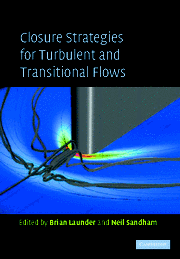24 - Direct Numerical Simulations of Separation Bubbles
Published online by Cambridge University Press: 06 July 2010
Summary
Abstract
In this chapter recent simulations of separation bubble flows are reviewed. This class of simulations contain a range of physical phenomena with laminar or turbulent separation and turbulent reattachment. Streamline curvature and extra rates of strain are present, compared to simple parallel shear flows. Simulations with initially laminar flow also contain a laminar–turbulent transition process. All this occurs within a simple geometry, providing good test cases for comparison with other predictive methods such as LES and RANS.
Introduction
Our discussion of separated flow DNS will be limited to separation of an incompressible laminar or turbulent boundary layer from a smooth flat surface. Either the boundary layer cannot follow a discontinuous change in the surface geometry, under nominally zero-pressure-gradient conditions (and the ‘surface separates from the flow’), or it is decelerated by an adverse pressure gradient (APG), with no change in surface curvature (and the ‘flow separates from the surface’). These cases are represented by, respectively, the flow over a backward-facing step, and the transpiration-induced detachment and reattachment of a flat-plate boundary layer. Both configurations include reattachment, leading to a closed separation bubble. The present focus is upon three-dimensional simulations in two-dimensional geometries, for Reynolds numbers low enough that all (or nearly all) relevant scales of motion can be explicitly resolved. Two-dimensional computations of transitional separation bubbles (e.g. Pauley et al. 1990), and higher-Reynolds-number LES of the backward-facing step are not considered here. Neither are the very low Reynolds number DNS of bluff-body flows (circular and elliptic cylinders, spheres, normal flat plates, and finite-thickness aerofoils), which often involve interaction of surface curvature and APG effects (Karniadakis and Triantafyllou 1992; Zhang et al. 1995; Najjar and Balachandar 1998; and Mittal and Balachandar 1995).
Application of DNS to separated flows is a challenging task. The heart of the challenge lies in the numerical issues introduced by the streamwise variation inherent to any separated flow.
- Type
- Chapter
- Information
- Closure Strategies for Turbulent and Transitional Flows , pp. 702 - 719Publisher: Cambridge University PressPrint publication year: 2002



